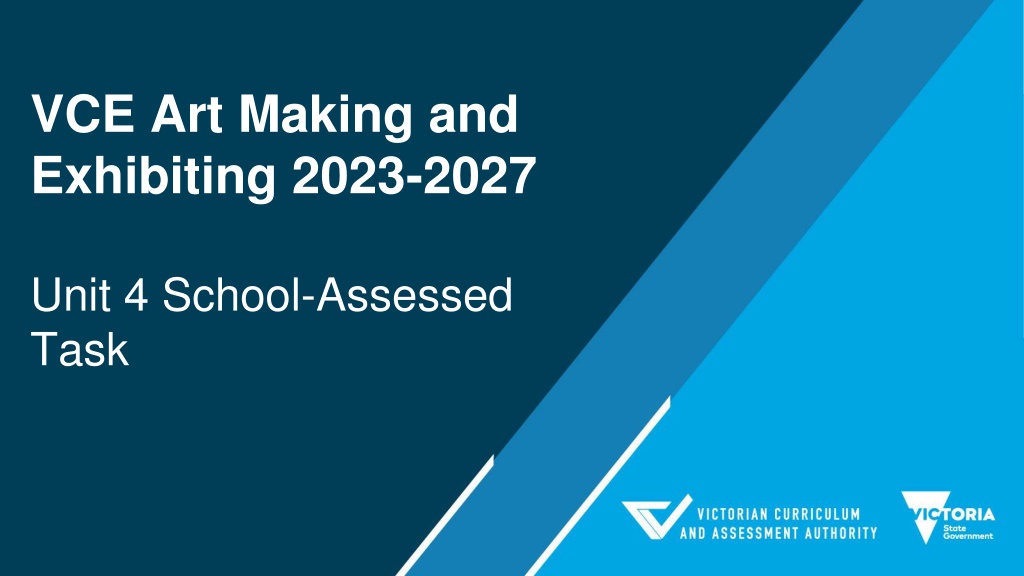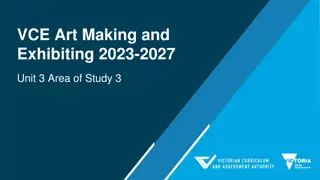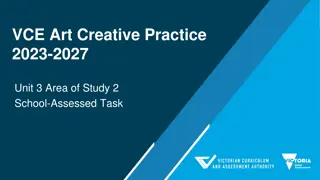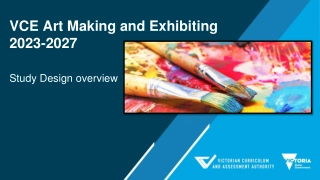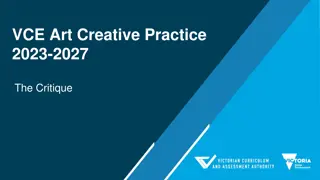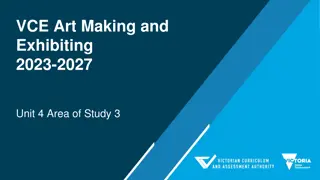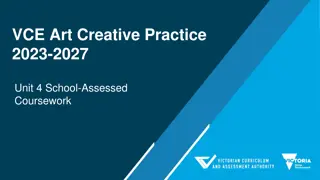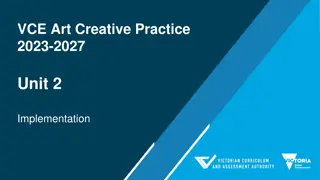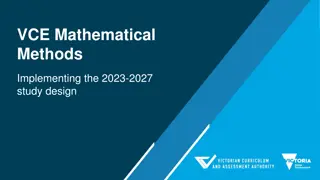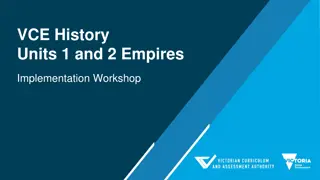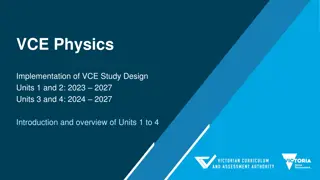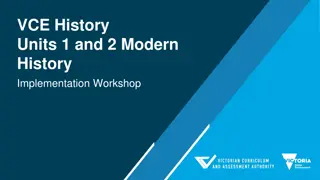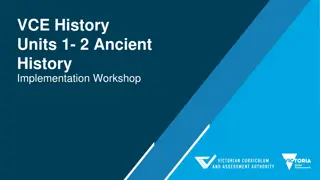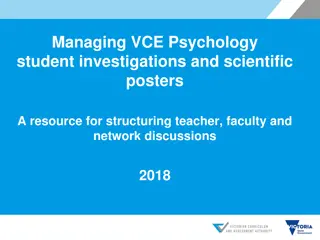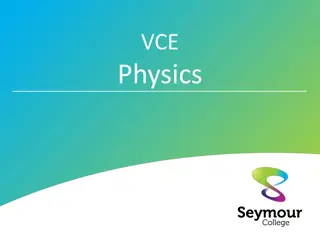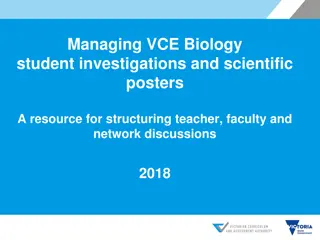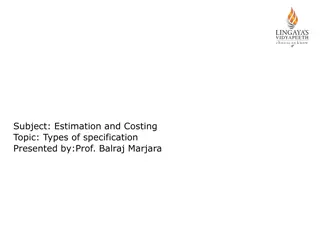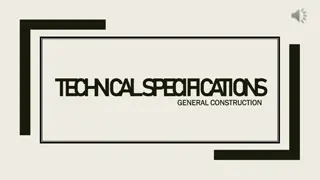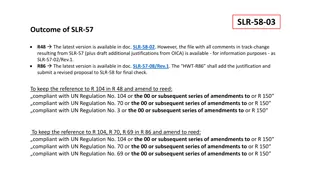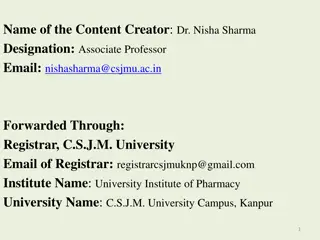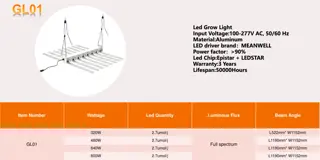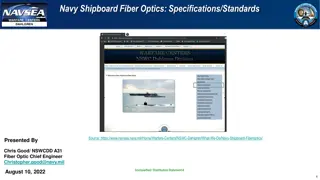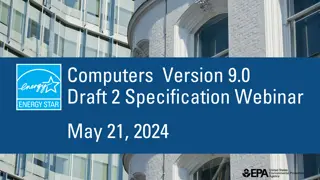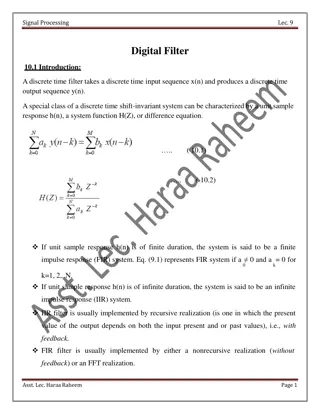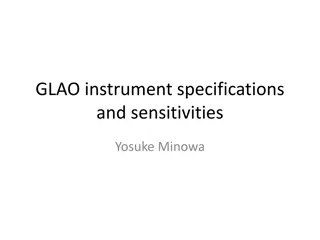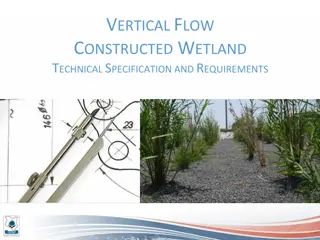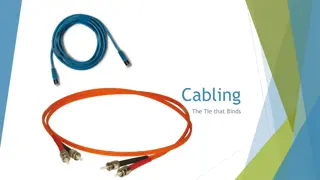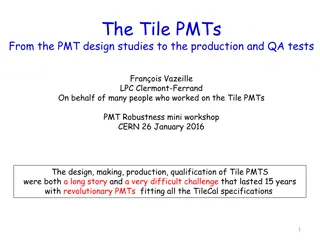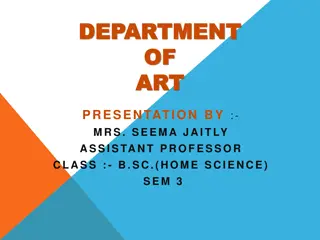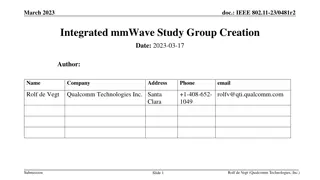VCE Art Making and Exhibiting Study Specifications
Explore, expand, investigate, understand, develop, resolve, collect, extend, connect, consolidate, present, and conserve various aspects of making and exhibiting art in the VCE curriculum. The study specifications cover creating artworks, planning exhibitions, curating, conserving materials, and understanding art elements, principles, forms, contexts, influences, and critique.
Download Presentation

Please find below an Image/Link to download the presentation.
The content on the website is provided AS IS for your information and personal use only. It may not be sold, licensed, or shared on other websites without obtaining consent from the author. Download presentation by click this link. If you encounter any issues during the download, it is possible that the publisher has removed the file from their server.
E N D
Presentation Transcript
VCE Art Making and Exhibiting 2023-2027 Unit 4 School-Assessed Task
VCE Art Making and Exhibiting Unit 4 School-assessed Task Outline Features of Art Making and Exhibiting Overview of Unit 4 Area of Study 1 and 2 Teaching ideas Unit 4 Area of Study 1 and 2 Assessment ideas School-assessed Task
VCE Art Making and Exhibiting Study specifications Explore Expand Investigate Understand Develop Resolve Collect Extend Connect Consolidate Present Conserve
VCE Art Making and Exhibiting Study specifications: Making artworks Explore Expand Investigate Understand Develop Resolve Collect Extend Connect Consolidate Present Conserve Artforms Ideas and meaning Techniques Making artworks Visual Language Processes Art elements and Art Principles Materials Aesthetic qualities
VCE Art Making and Exhibiting Study specifications: Exhibiting artworks Planning and producing the layout and design of the exhibition and planning the flow of the exhibition, including sight lines, spatial relationships, viewer interaction and interpretation. Includes the creation of display furniture, selection of fixtures and use of lighting. Exhibition design Determining the theme or story to be told in an exhibition. Curation includes the selection of artworks, writing the introduction to the exhibition, deciding where artworks will be placed, the designing of viewer interaction and interpretation, and the preparation of condition reports of artworks. Curation Planning, organising and undertaking the preservation and conservation of materials and objects in private, public and community collections, including art galleries, museums, other exhibition spaces and site-specific spaces. Conservation
VCE Art Making and Exhibiting Study specifications: Exhibiting artworks Explore Expand Investigate Understand Develop Resolve Collect Extend Connect Consolidate Present Conserve Museums Exhibition design Galleries Curation Other exhibition spaces Conservation Site specific spaces
VCE Art Making and Exhibiting Study specifications: Study Terms Art elements Art principles Art forms Contexts Critique Influences and inspiration Visual language Aesthetic qualities
VCE Art Making and Exhibiting Unit 4: Consolidate, present and conserve Consolidation and extension of ideas from Unit 3 in art making Use of the Unit 3 critique to broaden ideas and art making Resolution and refinement Presentation of finished artworks from art making Research into the presentation, conservation and care of artworks Area of Study Inquiry focus Area of Study 1 Consolidate refine and resolve How do artists refine and resolve artworks? Area of Study 2 Present plan and critique How are ideas presented in finished artworks on exhibition? Area of Study 3 Conserve present and care What role does conservation and care have in the presentation of artworks?
Art Making and Exhibiting Unit 4:Consolidate, present and conserve Area of Study Outcome Assessment On completion of this unit the student should be able to refine and resolve at least one finished artwork in a specific art form and document the materials, techniques and processes used in art making. School- assessed Task Area of Study 1 Consolidate refine and resolve On completion of this unit the student should be able to plan and display at least one finished artwork in a specific art form, and present a critique. Area of Study 2 Present plan and critique On completion of this unit the student should understand the presentation, conservation and care of artworks, including the conservation and care of their own artworks. School- assessed Coursework Area of Study 3 Conserve present and care
Art Making and Exhibiting Unit 4 Finished artworks In Unit 4 students make connections to the artworks they have made in Unit 3, consolidating and extending their ideas and art making to further refine and resolve artworks in specific art forms. The progressive resolution of these artworks is documented in the student s Visual Arts journal, demonstrating their developing technical skills in a specific art form as well as their refinement and resolution of subject matter, ideas, visual language, aesthetic qualities and style. Throughout the unit students demonstrate their ability to communicate to others about their artworks. Students articulate the development of subject matter, ideas, visual language, their choice of materials, their understanding of the inherent characteristics and properties of the material, their use of techniques and processes, and aesthetic qualities. Acting on their critique from Unit 3, students further develop their ideas and broaden their thinking to make new artworks.
Art Making and Exhibiting Unit 4 Visual Journal The Visual Arts journal in Unit 4 includes: the continued development of the student s own art making in a specific art form evaluation of art making in a specific art form the visual documentation of the processes used for finalising artworks annotations to support visual documentation research into the connections between specific artists and artworks and the student s own artworks research about the presentation of artworks in exhibitions research undertaken for conservation and care of artworks research about the selection of artworks for display and the planning of exhibitions written and visual research to make connections with specific artists and artwork.
Art Making and Exhibiting Unit 4 Area of Study 1: Consolidate refine and resolve On completion of this unit the student should be able to refine and resolve at least one finished artwork in a specific art form and document the materials, techniques and processes used in art making. Outcome 1 How do artists refine and resolve artworks? What ideas from Unit 3 will I expand upon in Unit 4? How will I demonstrate the connections between artworks in Unit 3 and the finished artwork in Unit 4? How will I refine materials and techniques in a selected art form? How will I resolve subject matter and visual language in my finished artwork? How will I reflect on my art making in the visual journal? Learning structure
Art Making and Exhibiting Unit 4 Area of Study 1: Consolidate refine and resolve Key knowledge methods used to refine and resolve visual language in artworks methods used to extend and resolve subject matter and ideas in artworks the application of materials, techniques and processes to refine at least one finished artwork in a specific art form methods used to progressively document and record art making and the resolution and refinement of at least one finished artwork in a specific art form methods used to reflect and evaluate how subject matter and ideas are extended from Unit 3 and resolved in at least one finished artwork in a specific art form methods used to reflect on and evaluate the materials, techniques and processes used to make at least one finished artwork in a specific art form terminology used in the reflection and evaluation of art making and the refinement and resolution of at least one finished artwork in a specific art form methods used to conserve and care for the materials used in a specific art form terminology used to discuss the conservation and care of materials used in a specific art form
Art Making and Exhibiting Unit 4 Area of Study 1: Consolidate refine and resolve Key skills refine and resolve visual language in at least one finished artwork refine the use of materials, techniques and processes explored in Unit 3 to make at least one finished artwork in a specific art form progressively document and record art making and the resolution and refinement of at least one finished artwork in a specific art form reflect on and evaluate the expansion and resolution of ideas from Unit 3 in at least one finished artwork in a specific art form reflect on and evaluate the resolution of visual language used to communicate subject matter and ideas in at least one finished artwork in a specific art form reflect on and evaluate the use of materials, techniques and processes to make at least one finished artwork in a specific art form apply terminology in the reflection and evaluation of art making and the refinement and resolution of at least one finished artwork in a specific art form identify and discuss the methods used to conserve and care for materials used in a specific art form apply terminology in the discussion of the conservation and care of materials used in a specific art form extend and resolve ideas explored in Unit 3 in at least one finished artwork
Art Making and Exhibiting Unit 4 Area of Study 1 Teaching and Learning Ideas Use feedback collected in the Visual Arts Journal to further develop and extend thinking about how to make at least one finished artwork in Unit 4 Use the Visual Arts Journal to record and document the process of making at least one finished artwork. Document and explain the development and refinement of a specific skill using written and visual material in the Visual Arts Journal. Collect visual and written material to document at least one finished artwork to explain and justify the refinement and resolution of aesthetic qualities, ideas, influences, inspiration, style, subject matter and visual language Use visual documentation of at least one artwork to refine and evaluate the selection and application of materials, techniques and processes. Identify, discuss and document the connections between the artworks made in Unit 3 and Unit 4
Art Making and Exhibiting Unit 4 Area of Study 1 Detailed learning example Answer the following questions to reflect upon and evaluate at least one finished artwork in Unit 4. Present responses to the questions below alongside visual material in the Visual Arts Journal. What was your artistic intention and how did you achieve it? How did you generate ideas for the artwork based upon the artworks completed during Unit 3? What influenced you when selecting an artform? Describe your process of making artworks. How has your process been influenced by an artist you have researched this year What specific techniques did you need to practise in order to make the artwork? What are the properties of materials used to make the artwork? How did artistic influences help to develop ideas for your art making? What challenged did you encounter and how were these resolved? What ideas or suggestions did you get from critiques and how was their feedback used to develop and resolve artworks? How would you explain your visual language? How has it evolved since Unit 3? How did your manipulation and application of art elements and art principles help you to achieve the aesthetic qualities in the artworks? How might viewers interpret the artwork?
Art Making and Exhibiting Unit 4 Area of Study 1 Assessment Students make at least one finished artwork in a specific art form that expands on the artworks that they completed in Unit 3. At least one finished artwork must: demonstrate the refinement of materials, techniques and processes explored in Unit 3, in a specific art form demonstrate the extension and resolution of subject matter and ideas from Unit 3 demonstrate the resolution of visual language in the finished artwork. Students present the documentation used to inform art making in a Visual Arts journal, including reflection on and evaluation of the resolution and refinement of at least one finished artwork.
Art Making and Exhibiting Unit 4 Area of Study 1 Assessment Example Answer the following questions to reflect upon and evaluate at least one finished artwork in Unit 4. Present responses to the questions below alongside visual material in the Visual Arts Journal. What was your artistic intention and how did you achieve it? How did you generate ideas for the artwork based upon the artworks completed during Unit 3? What influenced you when selecting an art form to make the artwork? Is it the same art form as Unit 3? If not, why did you decide to change to another art form? Describe your process of making artworks. How has your process been influenced by an artist you have researched this year? What are the properties and characteristics of the materials used to make the artwork? How did you develop and enhance your skills in using materials, techniques and processes? What specific techniques did you need to practise in order to make the artwork? How did artistic influences help to develop ideas for your art making? How have other artists inspired or influenced your art making? What challenges did you encounter and how were these resolved? What ideas or suggestions did you get from critiques or other mentors and how was their feedback used to develop and resolve artworks? How would you explain your visual language? How has your visual language evolved since Unit 3? How did your manipulation and application of the art elements and art principles help you to achieve the aesthetic qualities in the artwork? How might viewers interpret the artwork?
Art Making and Exhibiting Unit 4 Area of Study 2 Area of Study 2: Present plan and critique On completion of this unit the student should be able to plan and display at least one finished artwork in a specific art form, and present a critique. Outcome 2 How are ideas presented in finished artworks on exhibition? Where am I going to display my finished artwork? How will I plan and document my presentation? What do I need to do to prepare for the critique? How will I evaluate my art making and my decisions in the critique? How will I represent my subject matter and ideas to communicate meaning in my finished artwork What art terminology do I need to know to discuss and evaluate my finished artworks? Learning structure
Art Making and Exhibiting Unit 4 Area of Study 2 Area of Study 2: Present plan and critique Key knowledge characteristics of the display of artworks in a specific space methods used to display finished artworks methods used to plan and document the display of finished artworks methods used to prepare and present a critique of art making and at least one finished artwork in a specific art form methods used to critically evaluate art making in a critique methods used to explain decisions made throughout art making in a critique methods used to present the representation of subject matter and ideas and the communication of meaning in at least one finished artwork in a specific art form art terminology used in discussion and evaluation of the presentation of a finished artwork in a specific art form and art making in a critique
VCE Art Making and Exhibiting Unit 4 Area of Study 2 Area of Study 2: Extend make, critique and reflect Key skills research and discuss the display of artworks in specific exhibition spaces plan and document the display of at least one finished artwork in a specific art form in a specific space present and evaluate at least one finished artwork in a specific art form in a critique prepare and present a critique of art making critically evaluate art making in a critique explain decisions made throughout art making in a critique present and explain the representation of subject matter and ideas and the communication of meaning in at least one finished artwork in a specific art form apply art terminology used in discussion and evaluation of the presentation of at least one finished artwork in a specific art form and art making in a critique research and discuss the characteristics of specific exhibition spaces
Art Making and Exhibiting Unit 4 Area of Study 2 Teaching and Learning Ideas Plan for the display of one artwork for a specific exhibition space that the students has visited or hypothetical based upon knowledge and understanding of exhibition spaces. Document the planning of the display in the Visual Arts Journal Write a short statement that provides an overview of at least one finished artwork that defines the student s intentions and the artwork s didactic information. Document the overview in the Visual Arts Journal and use this information as a starting point to prepare a presentation for the critique. Explain and illustrate how at least one finished artwork should be displayed, packed for transport and correctly stored. Provide detailed explanations and use step by step instructions, illustrations and images to show how the artworks should be, packed and unpacked prior to and after display. Explain and discuss the presentation of at least one finished artwork and include reference to any of the following considerations- artwork dimensions, cases or cabinets, framing, floor treatment, hang height, lighting, plinths, wall colour, relationship to the exhibition space and other artworks. During the critique, the Art Making and Exhibiting class can ask questions to the student presenting, to support reflection and explain the decisions they made while making artworks.
Art Making and Exhibiting Unit 4 Area of Study 2 Detailed learning example Presenting Illustrate, explain and discuss the presentation of at least one finished artwork and include reference to any of the following considerations: artwork dimensions cases or cabinets framing floor treatment hang height lighting plinths wall colour relationship to the exhibition space and other artworks Vitrines
Art Making and Exhibiting Unit 4 Area of Study 2 Detailed learning example Finding a hypothetical gallery space to display the artwork 1. Collect images of empty gallery spaces from the Internet. 2. Use images that are higher in resolution and can be imported into an image editing program such as Photoshop. 3. Import selected images of the empty gallery space into the image editing program and place photographs of at least one finished artwork into the selected spaces to demonstrate how the artwork should be presented in a gallery. Display Considerations - Lighting 1. Consider how lighting will affect the display of at least one finished artwork. 2. What lighting improves the appearance of the artwork and what type of lighting will create distractions? 3. How will the lighting temperature also affect the display of the artwork? 4. Record and document the ideal type of lighting that will complement the display of at least one finished artwork in the Visual Arts Journal.
Art Making and Exhibiting Unit 4 Area of Study 2 Detailed learning example Extension Activity Use the images of hypothetical exhibition space to make a maquette using foam- core or cardboard. Place the image of the finished artwork in the model to demonstrate how it will be displayed in space. Consider including images of artworks made during Unit 3 alongside images of artworks selected for study in Unit 3 Outcome 1 to create a model of an exhibition, alongside artworks that influenced the finished artworks. Document the maquette using photographs and place the images in the Visual Arts Journal.
Art Making and Exhibiting Unit 4 Area of Study 1 and 2 Assessment
Art Making and Exhibiting Unit 4 Area of Study 2 Assessment Students present a display and critique of at least one finished artwork to their peers or another group. For the task they: document the planning for the display of at least one finished artwork display at least one finished artwork, considering the specific exhibition space discuss their art making discuss the representation of subject matter and ideas and communication of meaning in at least one finished artwork reflect on written or verbal feedback from the critique.
Art Making and Exhibiting Unit 4 Area of Study 2 Assessment Example Presenting Illustrate, explain and discuss the presentation of at least one finished artwork and include reference to any of the following considerations: artwork dimensions cases or cabinets framing floor treatment hang height lighting plinths wall colour relationship to the exhibition space and other artworks Vitrines
Art Making and Exhibiting Unit 4 Area of Study 2 Assessment Example Critique Prepare a presentation that will support the delivery of a critique that explains the student s thinking and art making. The presentation needs to address the following: Development of ideas Use of visual language Presentation of artwork Resolution and refinement of at least one finished artwork. Conservation and care Identify the properties and characteristics of materials used to make at least one finished artwork. Record these observations using written and visual material in the Visual Arts Journal to explain: the conditions required to display, transport and store these objects the changes that will occur to materials over time and in specific conditions the measures and processes used to delay and minimise changes to materials over time. Present the findings in a report with the presentation of the artwork.
Contact Dr Kathryn Hendy-Ekers Curriculum Manager Visual Arts, Visual Communication Design and Media E: Kathryn.Hendy-Ekers@education.vic.gov.au T: 9059 5147 M: 0438471513
